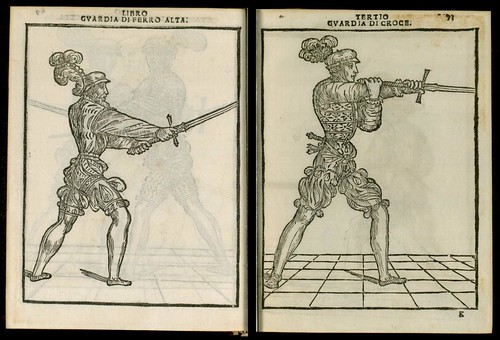
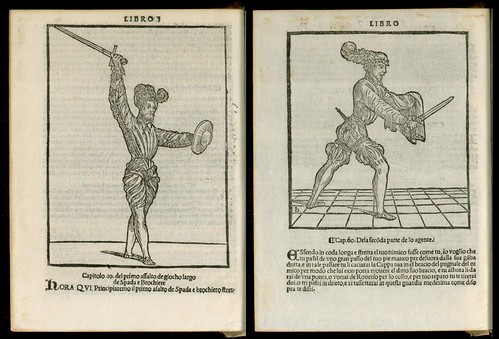

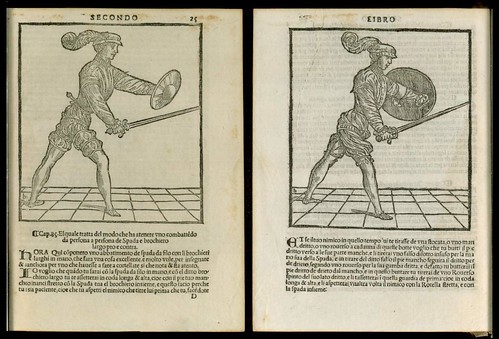

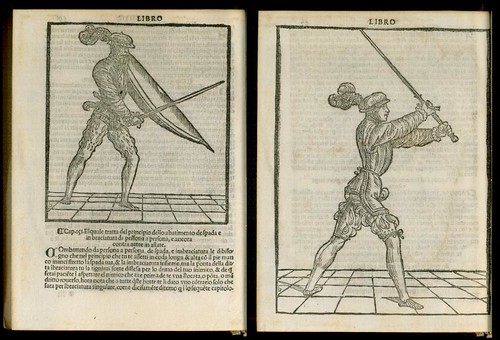
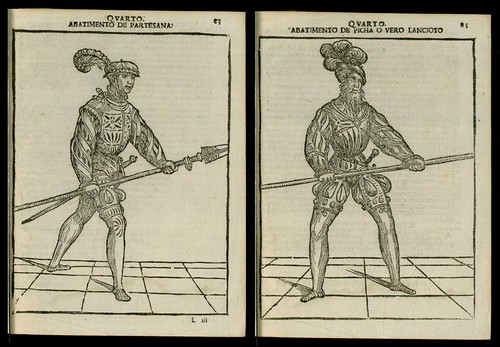
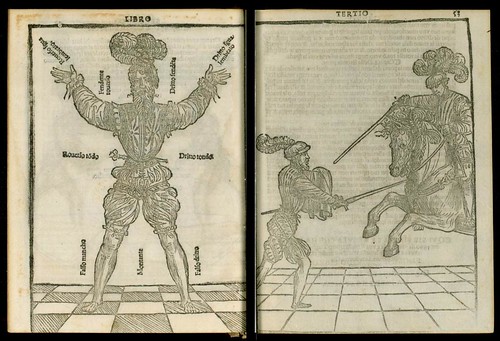
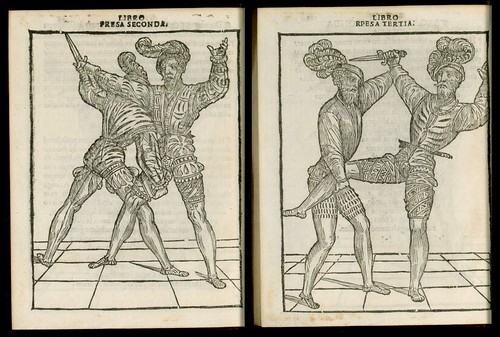
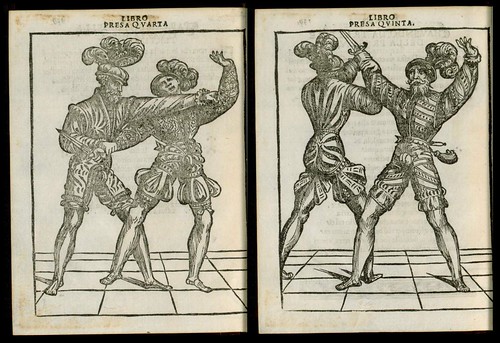



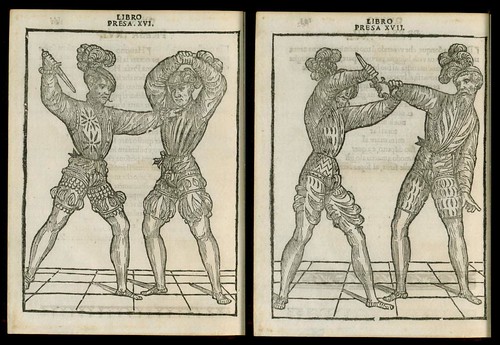


Fencing master, Achille Marozzo (1483-1553), was the most prominent and influential champion of the Dardi school of swordsmanship, which emerged in Bologna during the Renaissance.
Lippo di Bartolomeo Dardi's system of single-handed sword techniques bridged the gap between the cruder medieval cutting and slashing style and the nimble and more technically inclined¶ thrusting methods associated with the rapier. The latter system would come to dominate fencing in the 17th and 18th centuries.
¶It has been suggested in the comments below (and in another of the fencing posts on BibliOdyssey) that the differences between the sword -vs- rapier in terms of ease of manoeuvrability and range of offensive techniques that could be undertaken with each has traditionally been overstated. In other words, it's asserted that the rapier is not more agile, it was just a different, newer weapon.
Dardi (or Bardi) had established an academy early in the 15th century in Bologna and although no surviving treatise of his is thought to exist, his combat strategies were passed down through students and Marozzo published the definitive record of the school's principles in his 1536 book, 'Opera Nova dell'Arte delle Armi' (~new work on the art of arms).
Marozzo's 'Opera Nova' was the most important fencing manual of the 16th century and the first serious work to establish uniform rules for the use of weapons. It outlines theoretical considerations (derived from Aristotle, no less) and provides practical direction for both defensive and offensive use of swords, daggers and polearms in varying combinations, as well as the role of shields, bucklers and capes. There is a whole chapter devoted to honour, such were the noble aspirations of the project.
Further editions of 'Opera Nova' were published up until 1615 and the treatise continues to be used as a primary source in fencing academy instruction today. It is not the only reference publication in respect of the Bologna School, as contemporary works by Manciolino, Viggiani and Dall’Agocchie are also regarded as important ancillary commentaries.
- The complete first edition of 'Opera Nova' was put online last month by the Bayerischen Staatsbibliothek (contains eighty+ woodcut illustrations).
- Bolognese Swordsmanship: The Dardi School at Chicago Swordplay Guild.
- Bolognese Swordsmanship at the Order of the Seven Hearts.
- The Teachings of Marozzo By Giovanni Rapisardi & Edited By William E. Wilson (a translated commentary on Marozzo's 'Opera Nova' and related contemporary works).
- From Dueling to Fencing at Fencing Online (a history of the sword arts).
- Previously: Academy of the Sword and The Art of Fencing; and more generally: combat.
- I didn't note any current listings for 'Opera Nova', but there are: 'The Martial Arts of Renaissance Europe' by Sydney Anglo and 'Renaissance Swordsmanship' by John Clements.



























































8 comments :
Hello Biblio-
Excellent swordplay!
looking for a copy of the Ernst Haeckel photo(with Nicholai Miklukho-Maklai) and followed a path to your site. How wonderful! Like a big chocolate box of odd images. I was unable to access your contact e-mail, so am writing through comments. Do yo have any idea where I might find the Haeckel/Miklukho-Maklai photo? Thanks so much!
Thanks for the kind words.
You mean this photo?
I was really struck by the juxtaposition of the beautiful prints and the inherent violence of them and what they are teaching. I find it interesting that beauty and violence can be conveyed in the same image.
I'm just waiting for male fashion to return to all that fancy gear (plumed hats included) but could certainly do without quite so many knife fights.
This is going to sound really nerdy, but I'm very intrigued by how similar the grappling moves are to modern Aikido movements. For instance...
The first movement in picture "k" is very similar to a sayu nage.
The second movement in picture "m" is very similar to a sankyo.
The first movement in picture "n" is an almost perfect example of ikkyo
There are plenty of other examples that I'll spare you from referencing. I just found it interesting how different cultures all take advantage of human physiology in; often; the same ways.
I realize this sort of myth is so pervasive that it will never completely go away, but I have to comment anyway:
"Lippo di Bartolomeo Dardi's system of single-handed sword techniques bridged the gap between the cruder medieval cutting and slashing style and the nimble and more technically inclined thrusting methods associated with the rapier. The latter system would come to dominate fencing in the 17th and 18th centuries."
There was nothing crude about Medieval swordsmanship; it was every bit as 'nimble' and technical as the late Renaissance styles, and incorporated thrusting just as often as cutting. Additionally, the rapier is a highly specialized weapon, and in most ways inferior to the earlier swords which could both cut and thrust.
I expect that you were merely quoting another source with that blurb, so I'm not criticizing you; I just want to put the correct information out here.
Yeah ok. Someone intimated as much in another of the sword posts here. I'm not a swordsman or fencer so I can't comment per se, and yes I will have been paraphrasing from another source. I guess the points that occur to me are that 'crude' isn't a value judgement, it's a descriptive word deployed for comparison's sake and that, in my guesstimating, if, say a teenage novice girl attempted to touch a target on a wall in front of her by lifting each weapon as quickly as possible, it seems to me that there will be more precision with the lighter rapier. Is that incorrect? My sense is that you are referring to well versed swordsman who are dextrous and strong. In any event, that's just my perception and the wording you have quoted could perhaps have been more precise itself. I'll add a note in the entry. Thanks.
Rapiers of the mid 16th century aren't really any lighter than the single handed swords of the 15th century. The rapier blades are thinner true... but they are also longer. The weight is comparable. Further the oldest surviving manuscript we have is MS I.33 a German fighting manuscript which shows a very advanced, nimble and systemized fighting system for sword and buckler play.
Post a Comment
Comments are all moderated so don't waste your time spamming: they will never show up.
If you include ANY links that aren't pertinent to the blog post or discussion they will be deleted and a rash will break out in your underwear.
Also: please play the ball and not the person.
Note: only a member of this blog may post a comment.